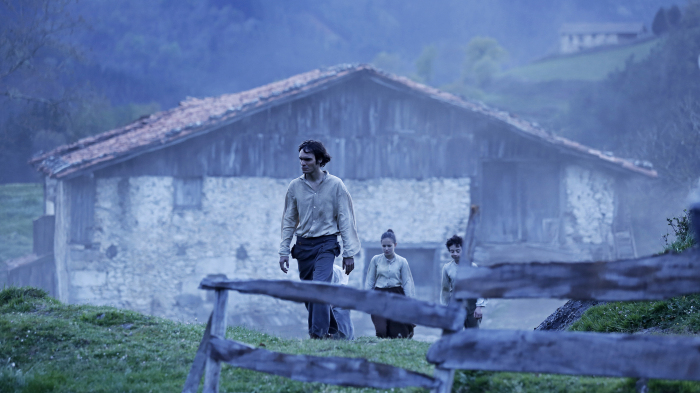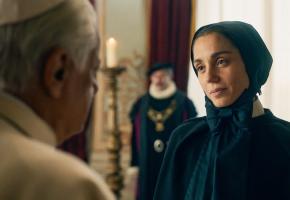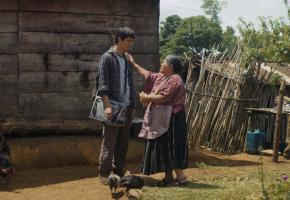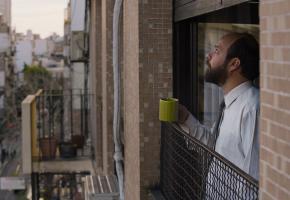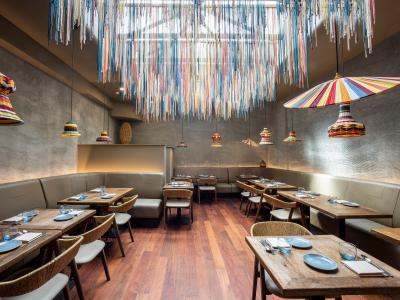Taking the story of Basque farm lad, Mikel Jokin Eleizegi Arteaga (played by Eneko Sagardoy), who started to grow uncontrollably when he was around 20 years of age, Jon Garaño and Aitor Arregi focused on the complex and moving relationship between Mikel Jokin and his brother Martín, (Joseba Usabiaga). They both love the same woman, Maria (Aia Kruse) and the rivalry between them works on many levels as they are financially bound together in their lives.
The film takes place during the unsettled historical period of the Carlist Wars, when the traditionalist Carlists were constantly fighting the Liberals. People were snatched from farms and cities to fight for years and their families faced penury as a result. Mikel Jokin’s immense height and the fact that he just could not stop growing, meant he could not help his father on the farm. Upon Martin’s return from the wars, where he lost an arm, it is clear that they risk losing the farm and their livelihoods, so they accept an entrepreneur’s invitation to take the giant brother on tour like a freak show. The gentle Mikel Jokin finds this experience excruciating, but he reluctantly agrees to go as he understands that he must do it for his family to survive. Their lives become so interlinked that one brother cannot survive without the other.
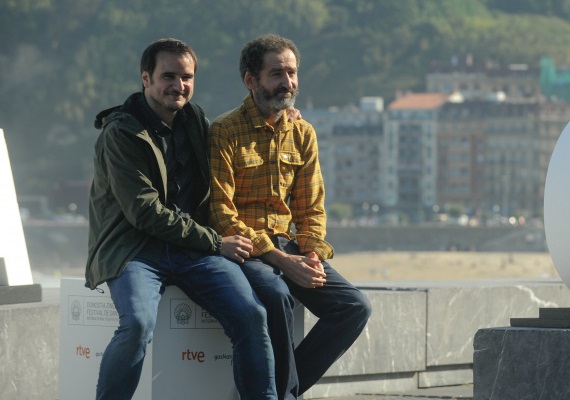 directors Jon Garaño and Aitor Arregi
directors Jon Garaño and Aitor Arregi
When I meet the enthusiastic directors, Aitor Arregi who tellsme that this extraordinary tale of the Giant was finally made into a film because for years and years, Garaño had persisted in his conviction that it should be filmed. Jon Garaño replies:
“It happens that there is a museum in San Sebastian, where I come from, where they have some of his actual personal garments. [massive gloves, his gigantic chair and shoes]. There are not many items, but since I was a child, I had been told about this story and it had always been going around my head. When I started to make films, I made the decision that I would film this story someday… [However], the film deals a little with things that are true, but also things that are not… iconography and fiction. That is, in effect, how we tell our stories, we magnify and deform them. One thing that is definitively rooted in everyone’s belief, however, is that the bones were stolen from the cemetery in Altza, and that they were taken to a museum in Britain.”
I then discover that Garaño and Arregi were late to our meeting because they had been visiting the British Museum to try to find out where the bones could be found. Garaño admits that so far, it remains a mystery: -
“According to a Basque forensic scientist… because of the age of the bones, together with the size, he is convinced that they are in the Museum of Mankind in Paris… but it has not been proven. [The scientist] believes that if he were granted five minutes with the bones he could get a chance to analyse the DNA and it could be ascertained. We are now fantasizing about making a short, complementary appendix to the film, about the search for the Mikel Jokin’s bones!”
As both directors’ comment, there was an eerie quality to the way all his clothes and personal items started to disappear as soon as he had died. So much so, that Garaño and Arregi began to wonder whether Mikel Jokin had ever existed at all. Few actual printed accounts survive from the time, including a couple of drawings, and even these are greatly exaggerated: -
According to Garaño this gave them an advantage:
“At the beginning, we were concerned there was not enough available material with which to make this film, but then we realized that, in many ways, it fitted the sense of the thesis of the production… which is how stories are magnified and distorted. This comes up in the film, no? The characters do it themselves, [to attract audiences]. They deliberately spread rumours about the Giant that were not true… so in the end, the film is yet another step in this gradual deformation of this tale, [and the ‘mythification’ of this personality].”
Fake news aside, the story of this Giant tapped into ancient myths that had always prevailed in the Basque region, especially during those times when there was conflict between the old world and the new, represented here by the war between the traditionalists who wanted their way of life to remain unchanged, and the liberals who wanted to move towards what they saw as progress. In GIANT, there is the feeling of a constant threat lurking in the forests and in the background. In reality, small farms were in constant danger from attacks from wild animals, and people would relate exaggerated stories when they gathered to work on the harvest: -
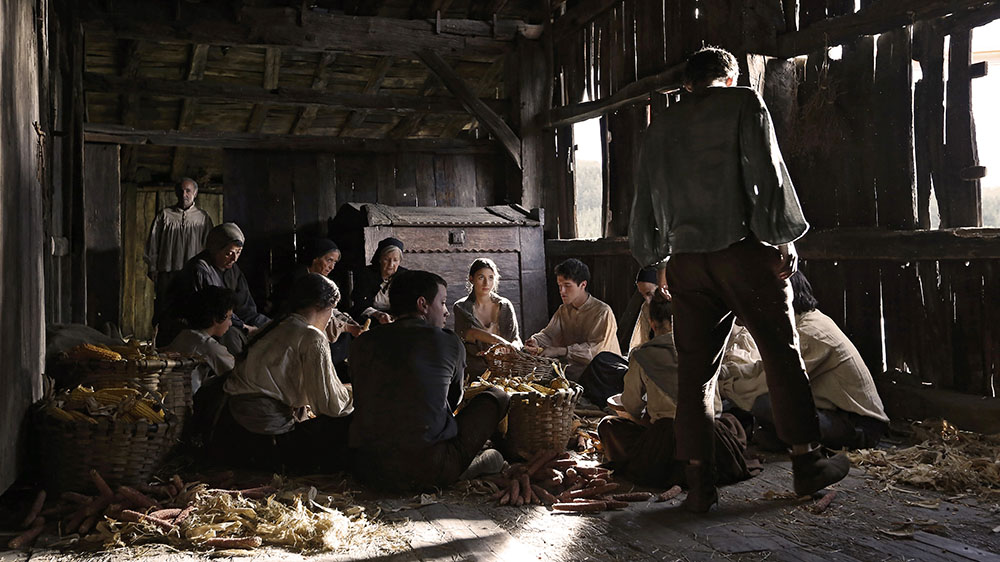
“There is also the symbol of the wolf. It is a threat on two levels. For example, at the beginning Martín is the one who embraces progress, he strokes the wolf cub in the forest while his brother flees with fear. It is a metaphor for something that is coming that cannot be stopped. That cub may now be small but it will grow. Finally, precisely at the moment when the gentle giant finds there is literally no more physical space left for him, we see how he is terrified of what the wolf represents and yet again tries to flee… wolf packs were the scourge of farmers, they attacked the sheep and ruined the harvests ... so, when farm labourers met up in the evenings, in the dim light of the barns, if one were to casually mention that he had stumbled upon a mythological character on his way, he would be believed ... superstitious beliefs in forest witches and even Celtic spirits prevailed, not unlike those in Ireland. We wanted to touch on that… not in an obvious way, but we wanted to establish that this story had taken place when, although modern times were pushing in, everyone was still co- existing with these beliefs and superstitions.”
Not only does this tale describe how those times they were a-changing, but, also examines the whole concept of identity. Mikel Jokin refuses to learn Spanish and will only speak Euskera (Basque), his brother on the other hand not only learns Spanish, but also French and English. He sees it as a form of progress and herein lies the question of identity. Martín, by adapting so much, ends up losing his own direction, having deformed his own objectives so that they have become lost in time.
Aitor Arregi is aware that language forms a very integral part of a person’s identity: -
“… by learning Spanish [Martín thought] he was opening up to the new world…but on that journey, he begins to lose his dreams, and says to himself: ‘At what point did I stop aspiring to go to America and … betrayed myself and my identity?’ This concept of identity is also tied up with other themes in the film, not only in a cultural way, but individually, and ‘language’ is very much a part of that… so there is a duality… almost schizophrenic … because, according to where you are … different parts of your identity are accentuated… Mikel Jokin felt deeply that if he lost his language, he would lose his identity.”
These themes populate the film, making it multi- layered, but in the end, what remains is the memory of this gentle, warm character and the trials he had to face and the conflicted, but also loving, relationship he had with his brother. He suffered terribly with his gigantism and complained that could not sleep as he could hear the sounds of his bones growing at night! There is, therefore, a profound sadness that permeates the film, drawing as it does, on unease and distress around the whole idea of a freak show on a personal level and what it can mean to live on display in the world.
see our review of Handia (Ginat) here
Directors: Jon Garaño and Aitor Arregi
Screenplay Jon Garaño , Aitor Arregi, Jose Mari Goenaga and Andoni de Carlos
Cinematogapher Javier Agirre
Music Pascal Gaigne
Cast:
Maria Aia Kruse
Mikel Jokin Eleizegi Eneko Sagardoy
Martín Eleizegi Joseba Usabiaga
Antonio Eleizegi Ramón Agirre


